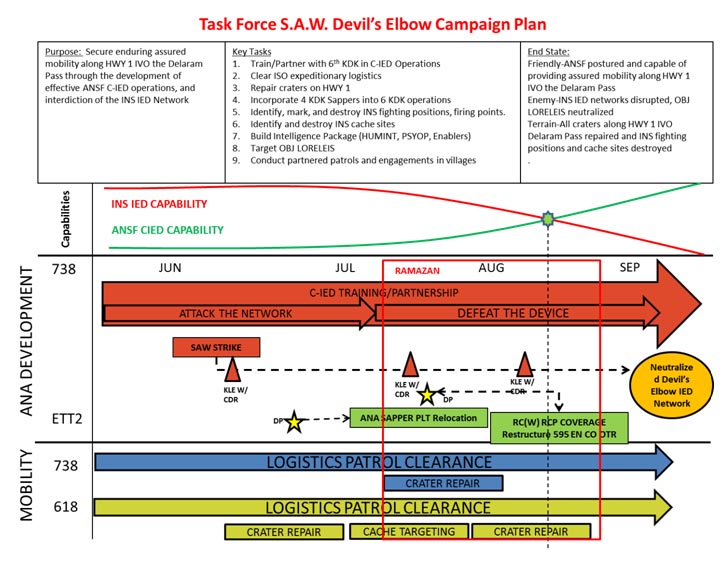A Partnership Forged in Hell: A Non-traditional Approach to Assured Mobility and Security Force Assistance in the Devil’s Elbow
Ryan Neely and Kevin Lawhon
It was just after 9:00 AM on May 28th, 2013. 2nd Platoon of the 738th Engineer Support Company (Airborne) was conducting a dismounted patrol with an Afghan infantry platoon from the 6th Kandak of the 207th Afghan National Army (ANA) Corps. As the patrol headed north along Highway 1, a local national chattered something indiscernible to several of the Afghan Soldiers. He then pointed emphatically towards Petawak Mountain to the north. Unexpectedly, the Afghan Soldiers immediately fled the area. Some of them jumped into bongo trucks, others mounted up into their Ford Rangers, and the rest fled on foot. A feeling of uneasiness set over the US Soldiers that remained. It became clear that danger was imminent on the road ahead.
The US Soldiers climbed into their armored vehicles as a precaution, and then pushed on with their mission. They came to an area where four ANA were killed in a road side bomb blast less than two weeks prior. Several destroyed vehicles canalized the patrol’s movement. The first two vehicles in the convoy cautiously cleared their way through the choke point. As the third vehicle rolled through, an earsplitting blast rocked the vehicle, mangling its solid steel cab. The force of the explosion was so significant that it stood the vehicle up on its rear hatch before it toppled over on its roof. Thick black smoke billowed from the vehicle and the smell of burning rubber choked Soldiers as they rushed in to pull out the casualties. As the casualties were being loaded onto helicopters, a group of enemy fighters bombarded the patrol with gunfire. The battle raged for 20 minutes before the insurgents were driven away. Those left there at the blast site were covered in blood, sweat and soot. Having fallen victim to another complex attack, it brought them to the realization that they could not secure the area alone. It would take the effort of the hundreds of ANA Soldiers to make a lasting difference and provide a persistent presence.
This article recounts the success, failures, trials, and tribulations of one Engineer Company and the unique circumstances of the security force assistance mission they attempted, and ultimately succeeded in from March to September of 2013 in the Devil’s Elbow. Their lessons were hard learned and their approach was unconventional, but it had an enduring impact on the battle space. The cast of characters is too many to list; what is more important is what they collectively achieved and the lessons they learned.
The Devil’s Elbow is a desolate, mostly uninhabited 40 kilometer stretch of Highway 1 in southwestern Afghanistan. It straddles numerous political and military boundaries, preventing it from being owned by any one entity. In short, the Elbow is the crucial link between Western and Southern Afghanistan that is no one’s problem. The Elbow crosses political boundaries established by the Government of the Islamic Republic of Afghanistan (GiROA): the border of Farah and Nimruz Provinces and the confluence of the four districts of Delaram, Bakwa, Gulistan, and Bala Baluk. It also sits at the fringes of military boundaries; it straddles the International Security-Assistance Force’s (ISAF) Regional Commands Southwest and West borders as well as the break between the Afghan National Army’s 207th and 215th Corps. There is no coalition base in the Elbow. The closest ISAF unit to the west is an Italian Army unit 150 kilometers away in Farah. To the east, there is a small base for Marine advisors in Delaram. Thus, ISAF presence was limited at the far reaches of coalition battle space. The terrain begins with wide, dusty plains in the southern portion and becomes littered with small hills before transitioning into rugged, spiny mountains rising two to three thousand feet. The terrain, distance from ISAF forces, and sparse dispersion of ANA forces gives insurgents’ complete freedom of maneuver in the Devil’s Elbow.
The closest Afghan military unit was the 2nd Brigade, 207th Corps of the ANA. Route security of Highway 1 in 2nd Brigade’s battles space fell to the 6th Infantry Kandak. The challenge facing 6th Kandak was staggering: 17 outposts, 400 Afghan Soldiers, 140 kilometers of Highway 1, a 40% desertion rate, and dozens of Soldiers killed each month. 6th Kandak, though rated as independent of coalition partnering, or advising was unsuccessful at its mission of securing Highway 1 in the Elbow. To complicate matters, ANA outposts were interspersed with Afghan National Police (ANP) outposts, with no clear delineation of responsibility between the police and the Army. Insurgents were bent on closing Highway 1 during the fighting season, cutting the only ground line of communication linking southern Afghanistan to the western provinces of Farah and Herat.
738th began operating in the Elbow in early March of 2013. After conducting route clearance in the open desert of Southern Helmand Province during the company’s relief-in-place, the 738th needed a real mission. Though an Army route clearance company had been stationed at Forward Operating Base (FOB) Dwyer for the last few years, the threat diminished in late 2012. 738th completed their relief-in-place on 6 March 2013 and four days later, were reconnoitering the Devil’s Elbow 250 km from the company’s home at FOB Dwyer. What they found was daunting. The highway in the Elbow was littered with the burnt and melted hulks of fuel trucks which had been attacked by insurgents during the months prior. A particularly brutal start to the fighting season left Afghan National Security Forces (ANSF) in the area undermanned and ill equipped. During the first month of the fighting season, they sustained nine IED strikes, countless ambushes, and 40 casualties. As a result, they were hesitant to leave their outposts. The Italian Military Advisory Team that once trained and fought beside them had been confined to their operating base by national caveats. The ANA were discouraged and in need of a helping hand.
Consequently, 738th conducted OPERATION JUNKYARD, a shaping operation to remove the remains of the fuel trucks, sanitize Highway 1 and build rapport with their Afghan counterparts. 738th identified key Afghan Police and Army leaders, used human intelligence to develop sources in populated areas, and leveraged other intelligence assets to better understand the enemy situation in the area. 738th built the foundation for future operations during OPERATION JUNKYARD and showed the Afghans they were willing to make an investment in the area. The next six weeks were relatively quiet. By the end of April, the company had settled at Camp Leatherneck, which reduced their commute to the Elbow by 100 kilometers.
In late April, insurgents launched the first major attack of the fighting season in the Elbow. Insurgents ambushed a fuel convoy, driven by their own countrymen, destroying six fuel trucks and wounding and killing a handful of drivers and security guards. 2nd Platoon, 738th had driven the route only minutes prior. They heard the gunfire and explosions and immediately turned their vehicles around to respond to the attack. When they arrived on scene, the contracted security guards for the fuel trucks had fled and the ANA seemed sluggish to respond. 738th braved gun fire and rocket propelled grenade (RPG) fire for nearly 45 minutes as they fought to dislodge insurgents from their positions on the side of Petawak Mountain. Once the fighting settled, they provided first aid to the truck drivers and escorted the convoy to a safer area. This attack made it clear that 738th would have to do more than just traditional route clearance in order to assure mobility through the Devil’s Elbow.
738th initially provided support in the form of route clearance and partnership 5-6 times a week; however, due to numerous limiting factors, the company found it difficult to provide the persistent presence needed in the Elbow. Though 738th was able to clear IEDs routinely, insurgents were still able to emplace them at will. Insurgents exploited the dead space between ANA outposts and the cover of darkness to place large improvised explosive devices (IED).
Each strike was a stark reminder that 738th had to get the Afghans out of their outposts and mobilize them to take greater ownership of the area. The 307th Engineer Battalion (Task Force SAW) decided to leverage the combat power of the 4th and 6th Kandaks of 207th ANA Corps, an Italian advisory team, ANA and ISAF Special Operations Forces, an Engineer Training Team (ETT), and three U.S. Engineer companies in a massive effort to attack the insurgent network in the northern portion of the Elbow. The nine day operation, called Operation SAW STRIKE, sought to get the ANA out of their outposts and into the local villages. Together with TF SAW, the ANA cleared three known insurgent strongholds. In addition to the village clearance operations, 618th Engineer Support Company and 704th Clearance Companies repaired several IED craters in Highway 1 and removed vehicle hulks. Simultaneously, the Embedded Training Team (ETT) advised the 4th Kandak Construction Company as it built an outpost near Petawak Mountain in an effort to dominate key terrain. The new outpost disrupted insurgent activity near Petawak over the next several months and gave the 6th Kandak their first, though limited, period to reconsolidate. The effects of the operation dramatically reduced violence in the northern portion of the Devil’s Elbow until after Ramazan. It also proved to the insurgents that the ANA were willing to push into the villages off Highway 1 in order to secure the population.
As cooperation increased between 738th and the 6th Kandak, a dialogue took place in the company about the nontraditional role that the 738th was developing with the Afghan infantry battalion. Though route clearance platoons (RCP) have traditionally been used to “snowplow” in front of convoys to defeat individual IEDs targeting convoys, the 307th Battalion Commander understood that the best CIED methodology was to do more than just defeat the devices, but also to attack the networks that placed the IEDs. This approach included never leaving the site of an IED without searching the area, talking to locals, collecting as much physical evidence as possible, entering bystanders into biometrics systems, monitoring radio networks used by the insurgents, and flying unmanned aerial platforms to observe actions outside the immediate field of view. With this approach, 738th had the freedom, and directive, from higher to pursue greater cooperation with the 6th Kandak. Additionally, though an unconventional partnership, the 738th and 6th Kandak shared the same mission: the mobility and security of military and civilian traffic on Highway 1 in the Elbow. Despite one unit of the partnership being a host nation infantry Kandak and the other a U.S. Army Engineer Company, the partnership made sense.
The 738th was equipped as a traditional route clearance company, possessing specialty equipment like robots, the Buffalo interrogation vehicle, the Husky detection vehicle, and Electronic Counter-Measures (ECM). They balanced their pre-deployment training between defeating the device and attacking the network. The company had trained for route clearance for over a year, and many of the paratroopers had experience with small unit tactics and infantry-related skills. The 738th commuted 100 kilometers to the Elbow, and at least once during the average 4-5 day mission, both platoons lived in tactical patrol bases in the desert, circling the wagons against potential attacks. The platoons spent the other nights at one of the two closest, small ISAF outposts, sometimes only for a matter of hours before heading back into the Elbow.
The 6th Kandak was equipped as a standard ANA Infantry Battalion. They had 6 Tolais, the equivalent of a U.S. Army company: First through Fourth, Headquarters, and Heavy Weapons. Weapons Company, 3rd, and 4th occupied the Devil’s Elbow. They possessed Ford Rangers, International cargo trucks, M1151 up-armored Humvees, NATO caliber rifles and automatic weapons, and limited heavy weapons. Each outpost had a platoon of Soldiers, an officer in charge, no running water, and perimeters made from HESCO bastions. Soldiers went on leave every 3-4 months. Each outpost relied entirely upon an immature logistics system that brought them their supplies every day. Some outposts began to purchase livestock from local villagers and tapped into local wells, to reduce the frequency of the logistics convoys which were exposed to enemy activity while on the road. The training of the Soldiers was minimal, and few had any specialty skills. They learned only rudimentary tactics and the basics of military life. Discipline in the outposts and in battle was limited.
Though the initial motivation of the partnership was ensuring the Afghans would be ready to assume security and assure mobility in the Elbow when the US leaves, both sides came to see that the Afghans and Americans formed a combined team that filled in each other’s gaps. When the Afghans lacked technology, it was our job to help them develop methods to detect and clear IEDs. The Americans struggled to provide a more persistent presence on the route, due to living 100 kilometers away from the Elbow; the Afghans never left the Elbow. Even when the Americans were patrolling the Elbow, their area of influence was only 2-3 kilometer in each direction of the convoy. But the Afghans could mount a half dozen various patrols throughout the Elbow to saturate the route, and keep the enemy off balance. As time passed, a habitual relationship with the 738th provided them encouragement and confidence. A partnership was born.
Another key element of 738th’s partnership with 6th Kandak was the 12-man Military Advisory Team (MAT) composed of Italian Marines, assigned to advise the Kandak Headquarters. The MAT and 6th Kandak headquarters were co-located at a small Italian base in Farah Province. Early in 2013, the Italians were pulled back from advisory at the Tolai level and as a result, the Italians had only monthly presence in the Devil’s Elbow. The MAT’s knowledge of the 6th Kandak staff and headquarters was well-developed, and they enjoyed solid relationships based on daily interaction at their FOB. However, the MAT’s ability to reach out to the struggling outposts was limited. Over numerous visits to the Italian FOB, the 738th developed a strong and cooperative relationship with the Italians. To their credit, the Italians were never territorial or parochial, and 738th desired to work with, not supplant, the MAT. They welcomed 738th’s interest in their Kandak, and knew that cooperation would bring about the ultimate goal: the success of the 6th Kandak. The 738th became the Tolai and below advisors, based on their capabilities, while the MAT continued to refine mission command systems at the Kandak level. By mid June, 738th developed a plan to train and advise two of three Tolais of the 6th Kandak in the Elbow, while another company of TF SAW would advise the third Tolai. With barely three full months remaining in the deployment, no replacements for the 738th, and limited opportunities to train, the company quickly realized that goals for the security force assistance mission would have to be limited.
For training, 738th surveyed the 6th Kandak and Tolai leaders, and found that CIED training was the most pressing need due to the lethal IED threat targeting 6th Kandak each day, followed by medical treatment and weapons training. Each 738th platoon was assigned a Tolai to train, and conducted training 2-3 times per 4-5 day mission to the Elbow. The platoons developed solid relationships with the Tolais, facilitating more effective advising and training. Throughout June and July, 738th refined their training and advisory role as they learned more about 6th Kandak. 738th quickly discovered that 6th Kandak was reluctant to leave their outposts, though a crop of capable, seasoned combat leaders did exist. The IED threat along Highway 1 intimidated them into combat-ineffectiveness. The enemy had freedom of maneuver in the Elbow, and had no deterrent from emplacing IEDs in the night because 6th Kandak rarely patrolled at night. The outposts also patrolled erratically during the day, rarely patrolling all of Highway 1 in their sector, and hardly ever coordinating with adjacent Tolais to cover the boundaries.
Moreover, the ANA were almost as much foreigners in the Elbow as were the Americans. ANA were often assigned to units far from their home town. Many of them came from came from central and north Afghanistan, from the Uzbek, Hazara, and Tajik ethic groups. They were culturally, linguistically, and ethnically different from the locals in the Devil’s Elbow. They mistrusted the locals, and had settled into an “us” versus “them” mentality. Thus, the 738th eventually settled on two limited, but crucial, tasks as the end state of the company’s security force assistance:
- Daily counter-IED patrols synchronized between companies and the 6th Kandak in order to provide freedom of movement on Highway 1
- Village elders have growing relationship and trust with 6th Kandak in order to counter the influence of the Taliban
The 738th Commander issued the following guidance to the company, to help lay out expectations for the partnership:
- Conduct training in a way that increases the ANA leaders’ pride and respect. We cannot embarrass or demean any ANA Soldier, and must work through their chain of command.
- We are on a timeline, but they are not. Find the right balance of pushing them without damaging the relationship.
- Training methods: everything must be hands-on; no handouts or presentations. Consider building training lanes at the Tolai headquarters (HQ) outpost, and train them on Highway 1.
- Everything we teach them has to be Afghan sustainable. Simple tools that can be produced, maintained, and replaced along with simple execution methods is key.
- Counter-IED is the main effort for training, but training in other key areas in encouraged: medical, vehicle and weapon maintenance, accountability, tactics, etc.
- Sell the value of the training to the Tolai commanders, and remind them that their kandak and brigade want them to do it.
- Remember the crawl, walk, run approach- and that their run is probably our crawl level.
738th platoon leadership then developed their platoon security force assistance plans to meet the Commander’s Guidance. Each platoon trained one Tolai of the 6th Kandak, which consisted of three outposts in the Elbow. Most training was focused at the Company HQ outpost, where the ANA Tolai commander and most of the soldiers lived. The platoons identified classes to be taught to 6th Kandak Soldiers, such as IED indicators and change detection, components of IEDs, rudimentary interrogation methods, medical treatment, and basic weapons marksmanship. The platoons taught leaders how to organize patrols to maximize change detection, to coordinate with the 2nd Brigade Route Clearance Company (RCC) for IED reduction, to vary patrol patterns, and to coordinate with adjacent companies for mutually supporting patrols. 738th’s Non-Commissioned Officers (NCOs) were the primary instructors for the classes, and their initiative paved the way for useful, relevant classes for the 6th Kandak. NCOs made “Afghan sustainable” counter-IED equipment with readily available supplies: grapnel hooks from 550 cord and metal hooks and claws, and sickles from 738th’s tent poles (which couldn’t redeploy due to agricultural custom restraints) and angle iron fastened with 550-cord, tape, or rope. These basic tools gave the Afghans the basic tools to find and interrogate the deadly IED threat, versus $100,000 robots that the Afghans will never be able to repair. Platoon medics found large stockpiles of medical supplies at outposts that no Afghan soldiers knew how to use; medical classes focused on combat gauze and tourniquets provided the closest ANA capability to the U.S. ANA Combat Life Saver program. Lastly, weapons proficiency was lacking: muzzle disciple, weapons maintenance, and basic marksmanship fundamentals were absent. As a result, 738th’s squad designated marksmen and NCOs led ranges at the ANA outposts to refresh basic marksmanship skills and instill the confidence that comes from being familiar with a soldier’s equipment.
Training and advising the Afghans can be frustrating for American Soldiers. The Afghan desire to improve, to want to get better, is far different than our own. The 738th understood, in principle, that the methods and capabilities of the ANA would be different, but the greatest challenge was being able to envision, and then accept, the Afghan solution. During training and combined operations, accepting the Afghan solution often felt like compromising our standards. Looking back, the U.S. Army’s “no compromise” mentality on our training standards can be counterproductive during Security Force Assistance. Despite the challenges, the frequent engagement developed a true partnership and camaraderie between the two elements. Soldiers from the United States and Afghanistan began to see each other on a weekly basis, and see each other as comrades in a worthy struggle. Friendships developed. Many barriers were torn down during those hot, summer days suffering under the Afghan sun.
As the heat of the summer increased, so did the violence. Following Ramazan, senior leaders of the insurgency in Farah Province focused on choking Highway 1 for the remainder of the fighting season. The 738th and 6th Kandak partnership beganto disrupt the insurgents, and they were going to fight back. Intelligence reporting indicated that insurgents were planning to mass in the Devil’s Elbow and conduct major attacks on ISAF, ANSF, and logistics convoys. The enemy intensified their efforts in the southern portion of the Devil’s Elbow. The flat, desolate terrain prevented them from massing and conducting direct fire attacks as they had in the north, but they were able to take advantage of the wadi networks and cover of darkness to emplace IEDs. In a 1 km stretch of Highway 1, insurgents placed over 30 IEDs over a two-month period. Insurgents varied the composition of the IEDs so that they targeted the ANA on foot patrols, unarmored fuel trucks, as well as blast protected ISAF vehicles. The weight of increased violence began to thin the ANA ranks just as it had at the beginning of the fighting season. It was evident that they still needed time and space to build their own capacity.
Based on the success of Operation SAW STRIKE, 738th held discussions with 6th Kandak leaders about constructing a new outpost in the southern portion of the Devil’s Elbow shortly after Ramazan. The intent of the outpost was twofold; it would close the distance between ANA bases in the Devil’s Elbow and eliminate patrolling gaps, and it would over watch the IED hot zone that emerged in July and August. The Kandak commander agreed to an outpost in dominant terrain on the west side of Highway 1. He decided to place an anti-aircraft gun at the outpost along with a radio antenna site to improve communications between his forces in the Elbow. 738th helped the 6th Kandak request construction support and building materials from their headquarters The Kandak Commander also agreed to the Afghan led clearance of two villages in the Devil’s Elbow known for lethal aid trafficking. The combined ANA and 738th operation would be called OPERATION BLAZER FORGE.
738th ESC spent the next several patrols working with the 6th Kandak to refine their plan and garner support from 2/207 ANA. On August 18th, 2013, while meeting with the 6th Kandak Commander in Bala Boluk, 738th received reports of a major attack unfolding in the Devil’s Elbow. Taliban plans to cut off Highway 1 were coming to pass. Intelligence reports indicated 70-100 fighters from across the region pooled together in a well-coordinated effort to overrun a small 20 man outpost near the base of Petawak Mountain. 738th arrived on the scene 10 hours after the ambush started. The ANA were lobbing mortars at insurgent firing positions and exchanging small arms fire. 738th fought shoulder to shoulder with the ANA through the night. They also treated and evacuated a number of 15 casualties and coordinated air support, which drove the enemy from the area. They stayed on site through the night to prevent insurgents from over taking the ANA outpost. The next morning the 738th escorted the APPF out of the Devil’s Elbow to safety. Reconnaissance assets clearly identified at least 50 insurgents leaving the area, but they were unable to engage them. The enemy would live to fight again another day.
On August 28th, 2013, insurgents made another attempt to cut off Highway 1. The circumstances were nearly identical to the attack 10 days prior. Insurgents massed on Petawak Mountain and focused their efforts on an APPF convoy and the nearby ANA outpost. This time, 738th ESC arrived within the first hour of the fight. It appeared that there were only 15-20 insurgents on the mountain top, but the APPF element was decimated. They sustained 18 killed and another 15 wounded. While treating and evacuating a number of APPF casualties, 738th began to receive fire from the mountain top. Undaunted, 738th threw everything they had against the insurgents on the mountain. The fight raged on for the better part of an hour until enemy movement on the mountain ceased. As silence fell and the sun began to set, it appeared as though the enemy had been driven off the face of the crag. What happened next would turn the tide in the Devil’s Elbow.
Devastated by the enemy, the APPF fled the area. The ANA huddled in their outpost, low on ammo and intimidated. Unwilling to see the ANA and APPF fractured, and reluctant to see their progress reversed, the Soldiers of 738th ESC went up the mountain to assess the damage dealt and eliminate any further threats. They were led by their Platoon Sergeant, SFC Ricardo D. Young. SFC Young had been up the mountain numerous times and knew the terrain better than any other Soldier. He had led a mission to destroy enemy fighting positions during OPERATION SAW STRIKE. He knew that his patrol had dealt a significant blow to the enemy during the fire fight, but he also knew that a few insurgents may still be lurking.
As they crested a spur on the mountain, SFC Young’s element was engaged by five insurgents. They returned fire, downing two of them. In the engagement that ensued, 15-20 insurgents came over the top of the ridge and began raining automatic weapons fire on the 738th element. Two Soldiers were pinned beneath a barrage of bullets. SFC Young ran into the interlocking fires of the enemy in order draw their fire away. As a result, his two Soldiers were able to escape, but he was mortally wounded in the process. They continued to fight the enemy valiantly until they ran out of ammunition and water. Only then did they make a break down the mountain to their vehicles. With the mountain clear of all friendly forces, a torrent of airstrikes rained down on the enemy all night long. During the battle for Petawak Mountain, at least 36 insurgents met their match.
The Battle for Petawak Mountain underscored the need to strengthen ANA presence in the Devil’s Elbow. To that end, in early September, 738th ESC engaged the Commander of 2/207th ANA about expanding the original scope of OPERATION BLAZER FORGE. When 738th leaders met with the Brigade Commander in Farah, he had received reports that over 100 insurgents were killed during the battle. He claimed “the insurgent’s backs were broken.” With renewed confidence, he quickly mobilized his Brigade to capitalize on the insurgent void. The Brigade Commander brokered a deal with the Provincial Governor and the Afghan National Police to re-draw lines of responsibility in Farah Province. The police shifted their focus to Bala Baluk village, while the ANA consolidated their forces in the Devil’s Elbow. Less than two weeks after the fighting at Petawak, 2nd Brigade launched a 600-soldier operation to build four new outposts in the Devil’s Elbow. The new camps garrisoned an additional 250 ANA Soldiers at critical points along Highway 1 and in key terrain. 2nd Brigade also directed the relocation of 6th Kandak Headquarters to Deh Tut, near the top of the Devil’s Elbow, instead of Bala Baluk, which was nearly 70km west of the Elbow. They also established a district level Operational Coordination Center (OCC-D) to coordinate all security operations in the area. A month after the Battle for Petawak Mountain, the ANA coordinated with Afghan Special Operations elements (ANASOF) to conduct a massive two week long clearance in the Devil’s Elbow.
The results were remarkable. The new outposts eliminated dead space in the Devil’s Elbow. The ANA constructed an outpost at the base of the very spur SFC Young and his team climbed on the 28th. They also installed an observation post (OP) on the top of Petawak Mountain, a place once flooded with insurgent activity. A large Afghan National Flag now blows gently in the breeze as an undeniable symbol that the ANA own the area. They built another outpost along a river bed once used by insurgents to move lethal aid between Bakwa and Gulistan. They built a third outpost less than 500 meters from the IED zone in the southern portion of the Devil’s Elbow. They armed that outpost with an anti-aircraft gun, with a range of five kilometers, just as had been discussed during the planning phase of OPERATION BLAZER FORGE. They built a fourth outpost on the ruins of an abandoned village that insurgents had once used to cache IEDs and weapons moving in and out of Delaram.
Foot patrols left no stretch unguarded during a 24 hour period. The presence of the Kandak Headquarters and an OCC-D in the Elbow had a dramatic effect on the volume and synchronization of patrols. ANA were patrolling morning, afternoon, and at dusk and spending as much time outside their bases as they were inside. Some outposts even reported conducting CIED ambushes at night. The ANA began to build relationships with the local population and earn their trust, a vital first step to cooperative security. It was as though the events that unfolded on the 28th of August served as the catalyst the ANA needed to secure the area on their own.
For the next 60 days, the enemy fell silent. Logistics and fuel convoys were able to traverse the area unscathed. Significant activity plummeted as ANA confidence began to rise. By the middle of October, insurgents quietly faded into their winter safe havens rather than increasing their activity as is traditional at the end of the fighting season. By the end of October, 738th ESC redeployed to Fort Bragg, NC, confident that they made a difference in the Elbow and gave 6th Kandak a fighting chance to succeed.
738th ESC learned many hard fought lessons during their time in the Devil’s Elbow. Chief among them is the idea that the host-nation counterinsurgent should look more like the insurgent than the technologically advanced, institutionally mature US Army. Conventional, combined arms tactics and unsustainable logistics systems might work for the U.S. Military, but are unlikely to succeed for the Afghanistan National Army. To more effectively counter the Taliban, the ANA need to resemble the Taliban’s operating methods. Smaller, mobile units not tied to defensive positions, utilizing the element of surprise, platoon and below operations, heavy population engagement and information operations, and enforcement of limited governing functions would more effectively counter the Taliban. Who will provide repair parts for decades to come for the International and Ford vehicles sold by the U.S.? Will the Afghans properly employ their plethora of higher echelon units that provide command and control? Will the Afghan military be dependent on external assistance that will present U.S. policy makers with a dilemma for the foreseeable future? Perhaps the world’s most technologically advanced, well-trained military would do well to let its less mature host-nation partners design their own military.
Second, the partnership between US Engineer and Afghan Infantry was not foreseeable, but it was absolutely necessary and based on common goals. In essence, 738th ESC and 6th Kandak had the same mission; to clear and secure Highway 1 in the Devil’s Elbow. The 6th Kandak and the 207th Corps had been one of the last Afghan units to receive advisors below the battalion level, and yet they were one of the first units to lose them as a result of ISAF drawdown. In order to establish an enduring solution for the Devil’s Elbow problem set, 738th ESC had to pick up right where Italian advisors left off. Thankfully, the Italian advisors at the battalion level and above were not parochial and were willing to provide 738th ESC much latitude. 738th ESC fought shoulder to shoulder with their Afghan counterparts and built their confidence and camaraderie. The end result was a Kandak with the capacity and force posture to stand on their own two feet in the face of a hardened enemy.
Third, the mentorship of host nation forces that occurs out in the battle space is just as important, if not more so than the training that happens inside the FOB walls. Literacy and language barriers placed more challenging concepts out of reach for many Afghans. Small unit movement tactics, for example, were not well understood when they were sketched on a white board and taught through a linguist. Comprehension improved dramatically when 738th conducted practical applications outside the wire on concepts that were taught inside the FOB or outpost. The act of physically modeling a particular task or tactic in the combat environment drove most complex ideas home. During a time when most training and advisory unit activities take place on secure bases, 738th ESC was able to take advantage to their expeditionary mission set and get out and share the risk with the ANSF. Doing so earned credibility, built trust, and fostered cohesion.
Finally, the security forces assistance mission is a key task for all deployed units, not just those with a formal partnership relationship tasked by ISAF. 738th ESC and TF SAW understood the imperative for ANSF development and kept an eye out for unmet mentorship opportunities. They viewed the 738th’s role as mentors, teachers, and advisors in a manner that was not specific to branch or service. They identified those areas of the battle space where insurgent capability exceeded ANSF capacity and focused their efforts to address an unsatisfied need. As the retrograde continues in Afghanistan, US and Coalition presence will increasingly become an economy of force operation. Commanders will have to make tough decisions on how to best allocate their combat power and find creative solutions to mitigate risk. 738th ESC acted in both a traditional route clearance capacity and assumed a less conventional role as an advisory force to an infantry unit. As a result, they were able to bring to bear the enablers and additional training that gave the host-nation force he enough time and space to establish their own capability. This creative approach capitalized on the additional capacity 738th gained by moving from Dwyer to Leatherneck, the expeditionary nature of RCPs, and the secondary mission of engineers to fight as infantry to improve security in area outside of other unit’s operational reach.
The Battle for the Devil’s Elbow is far from over. Insurgents will likely re-group for at least one more fighting season before US and Coalition Forces depart. But what is clear is that 738th ESC and TF SAW gave the ANA the breathing room they needed to forge their own destiny and secure their own freedom. Practically, the efforts in the Elbow reduced the likelihood of insurgents fracturing Western and Southern Afghanistan by cutting the main highway. Having the Elbow in ANA control gives the GiROA a foothold in key terrain from which they can continue to control and exert influence in the contested southwest of the country. That is the legacy the Trailblazers will leave behind them.
Appendix 1: Photos Petawak Mountain in the Devil’s Elbow
Petawak Mountain was decisive terrain for the insurgency in western Afghanistan. The mountain provided commanding views of Highway 1 in the Devil’s Elbow. The Elbow was a crucial link between western and southern Afghanistan.
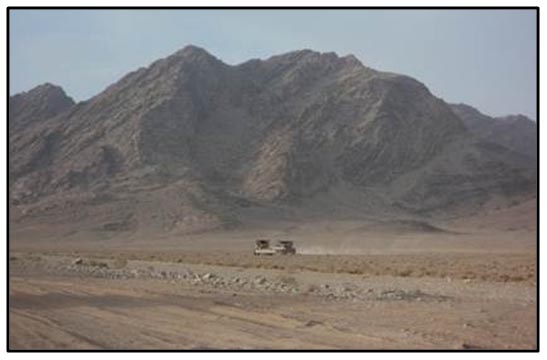
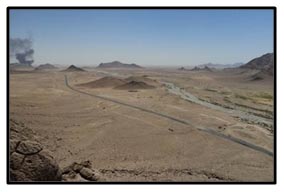
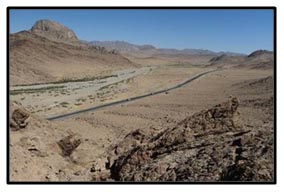
An all too common scene in the early days of 738th ESC’s deployment. Insurgents wantonly attacked civilian fuel convoys at will. They were bent on closing Highway 1 and choking out ISAF and ANSF supply lines.
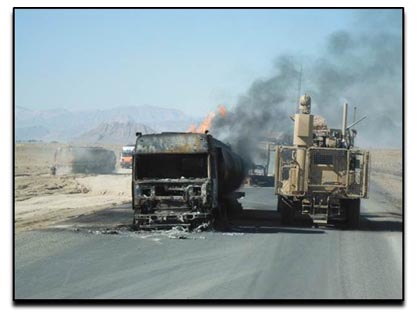
As part of SAW STRIKE, the ANA placed an anti-aircraft gun with a range of 5km on top of an outpost near Petawak Mountain. Between May and August, insurgent activity on Petawak Mountain fell silent. In August, following Ramazan, insurgents made one last major push to try and cut off Highway 1. They used Petawak Mountain to stage their attacks.
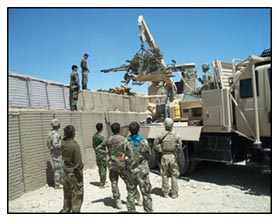
An Afghan Flag blows gently in the breeze on top of Petawak Mountain. The 207th ANA Corps took advantage the insurgent void and reclaimed Petawak as their own. Since August 28th, insurgents have fallen silent in the Devil’s Elbow.

Appendix 2: Aerial Representation of Afghan Forces in the Devil’s Elbow
Insurgents took advantage of the seam between military and political boundaries to traffick leathal aid from Bakawa to Gulistan. They also used the mountainous terrain in the northern portion of the Elbow to stage attacks against ISAF and ANSF elements.
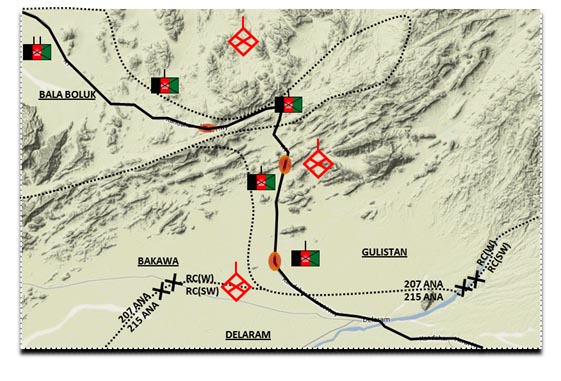
Appendix 3: TF SAW’s Campaign Plan for the Devil’s Elbow
738th ESC and their 6th Kandak partners had a common mission: to assure mobility through the Devil’s Elbow. To that end, they established a campaign plan to train and mentor the ANA to provide enduring security through one of the country’s most critical corridors.
